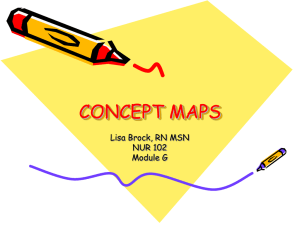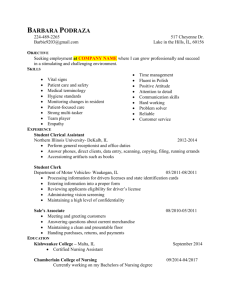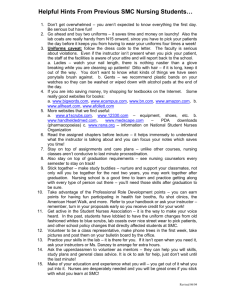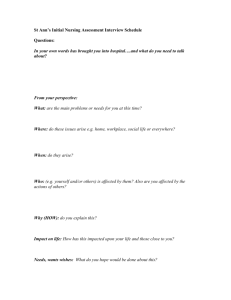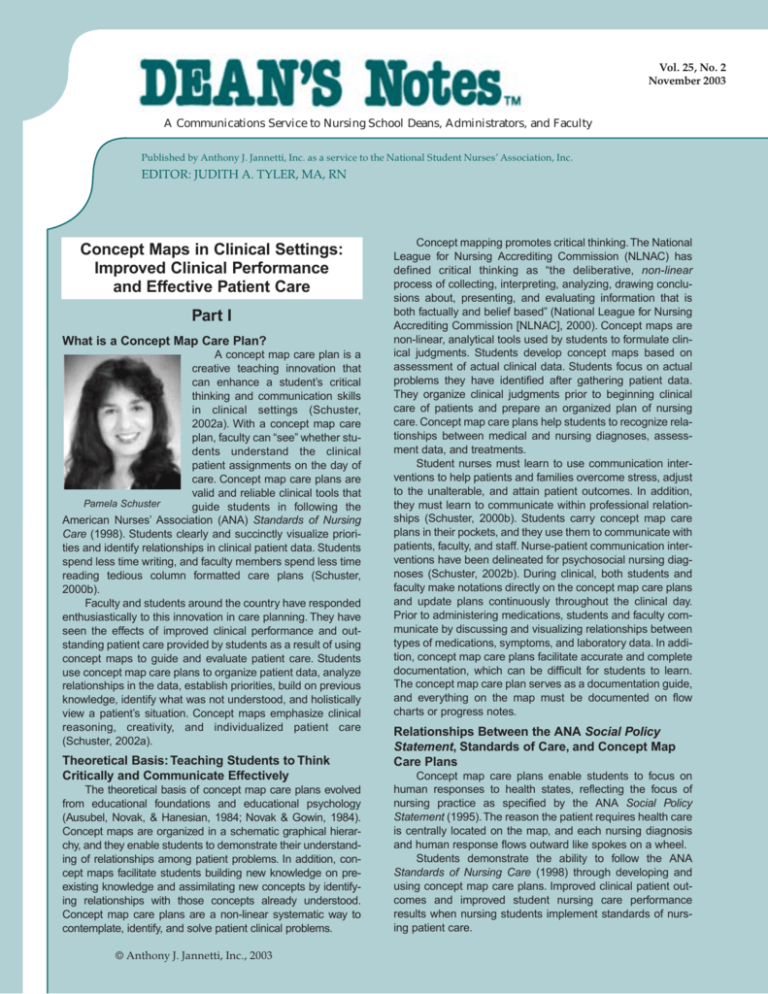
Vol. 25, No. 2
November 2003
A Communications Service to Nursing School Deans, Administrators, and Faculty
Published by Anthony J. Jannetti, Inc. as a service to the National Student Nurses’ Association, Inc.
EDITOR: JUDITH A. TYLER, MA, RN
Concept Maps in Clinical Settings:
Improved Clinical Performance
and Effective Patient Care
Part I
What is a Concept Map Care Plan?
A concept map care plan is a
creative teaching innovation that
can enhance a student’s critical
thinking and communication skills
in clinical settings (Schuster,
2002a). With a concept map care
plan, faculty can “see” whether students understand the clinical
patient assignments on the day of
care. Concept map care plans are
valid and reliable clinical tools that
Pamela Schuster
guide students in following the
American Nurses’ Association (ANA) Standards of Nursing
Care (1998). Students clearly and succinctly visualize priorities and identify relationships in clinical patient data. Students
spend less time writing, and faculty members spend less time
reading tedious column formatted care plans (Schuster,
2000b).
Faculty and students around the country have responded
enthusiastically to this innovation in care planning. They have
seen the effects of improved clinical performance and outstanding patient care provided by students as a result of using
concept maps to guide and evaluate patient care. Students
use concept map care plans to organize patient data, analyze
relationships in the data, establish priorities, build on previous
knowledge, identify what was not understood, and holistically
view a patient’s situation. Concept maps emphasize clinical
reasoning, creativity, and individualized patient care
(Schuster, 2002a).
Theoretical Basis: Teaching Students to Think
Critically and Communicate Effectively
The theoretical basis of concept map care plans evolved
from educational foundations and educational psychology
(Ausubel, Novak, & Hanesian, 1984; Novak & Gowin, 1984).
Concept maps are organized in a schematic graphical hierarchy, and they enable students to demonstrate their understanding of relationships among patient problems. In addition, concept maps facilitate students building new knowledge on preexisting knowledge and assimilating new concepts by identifying relationships with those concepts already understood.
Concept map care plans are a non-linear systematic way to
contemplate, identify, and solve patient clinical problems.
© Anthony J. Jannetti, Inc., 2003
Concept mapping promotes critical thinking. The National
League for Nursing Accrediting Commission (NLNAC) has
defined critical thinking as “the deliberative, non-linear
process of collecting, interpreting, analyzing, drawing conclusions about, presenting, and evaluating information that is
both factually and belief based” (National League for Nursing
Accrediting Commission [NLNAC], 2000). Concept maps are
non-linear, analytical tools used by students to formulate clinical judgments. Students develop concept maps based on
assessment of actual clinical data. Students focus on actual
problems they have identified after gathering patient data.
They organize clinical judgments prior to beginning clinical
care of patients and prepare an organized plan of nursing
care. Concept map care plans help students to recognize relationships between medical and nursing diagnoses, assessment data, and treatments.
Student nurses must learn to use communication interventions to help patients and families overcome stress, adjust
to the unalterable, and attain patient outcomes. In addition,
they must learn to communicate within professional relationships (Schuster, 2000b). Students carry concept map care
plans in their pockets, and they use them to communicate with
patients, faculty, and staff. Nurse-patient communication interventions have been delineated for psychosocial nursing diagnoses (Schuster, 2002b). During clinical, both students and
faculty make notations directly on the concept map care plans
and update plans continuously throughout the clinical day.
Prior to administering medications, students and faculty communicate by discussing and visualizing relationships between
types of medications, symptoms, and laboratory data. In addition, concept map care plans facilitate accurate and complete
documentation, which can be difficult for students to learn.
The concept map care plan serves as a documentation guide,
and everything on the map must be documented on flow
charts or progress notes.
Relationships Between the ANA Social Policy
Statement, Standards of Care, and Concept Map
Care Plans
Concept map care plans enable students to focus on
human responses to health states, reflecting the focus of
nursing practice as specified by the ANA Social Policy
Statement (1995). The reason the patient requires health care
is centrally located on the map, and each nursing diagnosis
and human response flows outward like spokes on a wheel.
Students demonstrate the ability to follow the ANA
Standards of Nursing Care (1998) through developing and
using concept map care plans. Improved clinical patient outcomes and improved student nursing care performance
results when nursing students implement standards of nursing patient care.
Standard 1 – Collection of health data. Students must
collect patient profile data pertinent to the clinical setting prior
to developing the concept map care plan. In addition, types of
patient data collected vary with the learning objectives for the
clinical day, the level of student abilities, the amount of time
the student spends with the patient, and the number of
patients in the student assignment. Students can only be held
responsible and accountable for what they have learned to
assess. Students continuously update maps as new assessment data is obtained, analyzed, and integrated into the plan
of care throughout the clinical day.
Standard 2 – Analysis of data to determine nursing diagnoses. Diagraming a concept map promotes critical analysis of
patient data and deduction of nursing diagnoses. After analyzing patient data that have been collected, students make a list
of key problems. Then, students begin by stating the reason the
patient is seeking health care in the center of the page. Next,
they list the major problems they have identified from the
assessment data in the boxes around the central reason for
health care. A template of a concept map is shown in Figure 1.
Figure 1.
Concept Map Template
#
#
#
Key Problem/ND
Key Problem/ND
Key Problem/ND
Supporting Data
Supporting Data
Supporting Data
Reason For Needing Health Care
(Medical Dx/Surgery)
Key Problem/ND
#
Key Problem/ND
*Faculty
Guidance for
Data don’t know
where to
put in boxes:
#
Supporting Data
Supporting Data
Key Assessments:
#
#
#
Key Problem/ND
Key Problem/ND
Key Problem/ND
Supporting Data
Supporting Data
Supporting Data
Problems are supported with clinical patient data, including abnormal physical assessment findings, treatments, medications, intravenous solutions, abnormal diagnostic and laboratory tests, medical history, pain, and psychosocial and spiritual problems. Students must also identify key assessments
that are related to the reason for health care and list them in
the central box. If the student does not know where patient
data should be placed on the map, they should put it off to the
side of the map and ask faculty for guidance in data analysis
(see Figure I). Next, students draw lines between related diagnostic problems to show that they recognize meaningful associations between diagnoses. The map becomes covered with
lines, and students soon come to realize that everything is
related. In this way, they can develop an understanding of the
concept of holistic patient care. Students also number nursing
diagnoses in order of priority. To finish the diagram, students
label each problem with a box available for the nursing diagnosis (see Figure 1).
Figure 2.
Template of Goals, Outcomes,
Interventions, and Evaluation
Problem # :
General Goal:
Behavioral Outcome Objective(s): The patient will......(do
what, say what, or have physical evidence).....on the day of
care.
Nursing Nutrition Interventions
1.
2.
3.
4.
5.
6.
7.
8.
Patient Evaluation of Responses
1.
2.
3.
4.
5.
6.
7.
8.
Summarize impressions of patient progress toward outcomes.
Source: Schuster, P.M. (2002). Instructor’s guide to concept mapping: A critical
thinking approach to care planning. Philadelphia: FA Davis.
Standard 3 – Identification of expected patient outcomes.
Students must identify goals and outcomes that are individualized to the patient. Students write general goal statements
and specific measurable behavioral outcome objectives for
the day of care for each nursing diagnosis (see Figure 2).
Standard 4 – Development of a plan of care with interventions to attain outcomes. Students will list goals, outcomes, and interventions in concept map care plans. For each
nursing diagnosis, students first develop a goal and the
patient’s individualized outcomes. In addition, nursing-specific
interventions to attain objectives are listed. Students include
ongoing physical assessments, monitoring equipment, laboratory reports that will be monitored, treatments and medications to be administered, and communication interventions
that are specific to the patient. The template shown in Figure
2 includes boxes for writing a goal, objectives, and interventions for a single nursing diagnosis. Prior to implementation of
patient care, students should use as many templates as
needed to list all goals, objectives, and interventions for each
nursing diagnosis.
Standard 5 – Implementation of nursing interventions.
The nurse implements interventions using the concept map
plan of care. As each intervention is performed in the clinical
setting, the intervention is checked off the list. Students can
easily track what they’ve done and what needs to be done
throughout the clinical day.
Standard 6 – Evaluation of patient progress toward
attainment of outcomes. Evaluation of patient responses is
also shown in Figure 2. Students record documentation of
physical and emotional patient data as responses to nursing
interventions. Last, they record documentation of impressions
towards outcomes.
Part 2 of this article will appear in the January 2004 issue
of Dean’s Notes, and will focus on the reliability and validity of
concept map care plans.
References
American Nurses’ Association. (1995). Nursing’s social policy statement. Washington, DC: Author.
American Nurses’ Foundation/American Nurses’ Association. (1998).
Standards of clinical nursing practice. Washington, DC:
American Nurses Publishing.
Ausubel, D.P., Novak, J., & Hanesian, H. (1986). Educational psychology: A cognitive view (2nd ed.). New York: Werbel and
Peck.
National League for Nursing Accrediting Commission, Inc. (2000).
Planning for Ongoing Systemic Evaluation and Assessment of
Outcomes. New York, NY: Author.
Novak, J., & Gowin, D. (1984). Learning How to Learn. New York:
Cambridge University Press.
Schuster, P.M. (2002a). Concept mapping: A critical thinking approach
to care planning. Philadelphia: FA Davis.
Schuster, P.M. (2002b). Instructor’s guide to concept mapping: A critical thinking approach to care planning. Philadelphia: FA
Davis.
Schuster, P.M. (2000a). Concept map: Reducing clinical care plan paperwork and increasing learning. Nurse Educator, 25(2), 76-81.
Schuster, P.M. (2000b). Communication: The key to the therapeutic
relationship. Philadelphia: FA Davis.
Dr. Pamela Schuster is a professor of nursing at Youngstown
State University in Ohio, with 21 years’ experience as a nurse
educator. She has diverse experiences as a clinician in medicalsurgical adult nursing and care of the chronically ill, and has
many publications on topics in clinical education and clinical
research. Dr. Schuster has been an American Nurses
Foundation Scholar and is currently a Distinguished Lecturer for
Sigma Theta Tau, speaking at national conferences and conducting day-long workshops. She obtained her BSN from Ohio
State University, her MSN from Kent State University, and her
PhD from Case Western Reserve University. Dr. Schuster can be
contacted by e-mail at paschuster@ysu.edu, by phone at 330549-3487, or in writing at Youngstown State University, One
University Plaza, Youngstown, Ohio 44555.
For more information about NSNA, contact
National Student Nurses’ Association
45 Main Street - Suite 606
Brooklyn, NY 11201
(718) 210-0705 • www.nsna.org
NSNA: We Make the Path by Walking It
Plan now to attend the 52nd Annual Convention of the National
Student Nurses’ Association (NSNA) in Nashville, TN, from March 31
through April 4, 2004!
NSNA invites you to attend its 52nd Annual Convention at the
Gaylord Opryland Resort and Convention Center. The theme is
NSNA: We Make the Path by Walking It. Be a part of this exciting
event. Network with colleagues from all over the country, hear outstanding speakers, learn about the latest issues and nursing trends,
develop your leadership skills, participate in the House of Delegates,
and much more!
Kicking off the convention is the Keynote Address by Barbara
Blakeney, president of the American Nurses Association, and an
expert in public health practice, and policy and leadership development. Prior to her role as director of health services for the homeless
with the Boston Public Health Commission, Barbara was the principal
public health nurse for homeless services and addiction services at
the Division of Public Health, Department of Health and Hospitals, in
Boston. She is the recipient of numerous awards and was honored by
Boston Women’s Magazine as one of the 100 women whose work
has contributed to the betterment of Boston.
Plenary Sessions
Two plenary sessions will provide up-to-date information on
issues facing the nursing profession today. On Thursday, April 1, the
National League for Nursing (NLN), New York, NY, will sponsor
“Students Rights and Responsibilities: A Socratic Dialogue.” On
Friday, April 2, Dr. Marilyn Chow, senior vice president for patient care
services, California Division for Kaiser Permanente and program
director for the Robert Wood Johnson Executive Nurse Fellows
Program, will speak on “Setting an Example: Leadership from the
Bedside to the Boardroom.”
Focus Sessions
Focus session topics will include impaired practice, financial
management for your future, nursing and the environment, healthy
heart living, adolescent health, obesity, disaster training, pain, end-oflife, and much more. Each session is repeated for your convenience.
NCLEX – Review Course
NSNA sponsors this 9-hour mini-review course for a nominal fee.
Awards Ceremony
NSNA will honor its special contest winners, and the Foundation
of the National Student Nurses’ Association (FNSNA) will pay tribute
to scholarship sponsors and recipients at the annual Awards
Ceremony on Thursday, April 1st. The Spirit of Nursing Award winner
is also honored during the ceremony. The Awards Ceremony is followed by a reception sponsored by the U.S. Army Recruiting
Command, Army Nurse Corps. All convention registrants are invited
to attend.
Exhibits
The exhibits are always an exciting part of the NSNA
Convention. Plan your future today by networking with hospitals,
agencies, schools of nursing, publishers, and more!
Project Showcase
NSNA members (students and faculty) are invited to showcase
their achievements by displaying projects in the Exhibit Hall. A special
exposition area will be set up for projects related to Community
Health, Legislation and Education, Breakthrough to Nursing,
Membership, Image, and Newsletters. All award-winning projects will
also be displayed. Exhibit your chapter’s best!
For more information, e-mail NSNA@NSNA.org
Once you have finished with this newsletter,
please pass it along to share with a colleague or friend.
Editor . . . . . . . . . . . . . . . . . . . . . . . . . Judith A. Tyler, MA, RN
President, NSNA . . . . . . . . . . . . . . . . . . . . . . . Matthew Arant
PRSRT STD
US POSTAGE
PAID
Bellmawr, NJ
Permit #58
Executive Director. . . . . . . . . . Diane Mancino, EdD, RN, CAE
Art Director . . . . . . . . . . . . . . . . . . . . . . . . . . . . . Jack Bryant
Managing Editor . . . . . . . . . . . . . . . . . . . . . . . . . . Carol Ford
Graphic Artist. . . . . . . . . . . . . . . . . . . . . . . . . . . . . Bob Taylor
Publisher . . . . . . . . . . . . . . . . . . . . . . . . . Anthony J. Jannetti
Advisory Board . . . Barbara Chamberlain, MSN, APRN, BC, ANP
DEAN’S Notes is indexed in Cumulative Index to Nursing &
Allied Health Literature.
DEAN’S Notes is published five times a year (September,
November, January, March and May) by Anthony J. Jannetti Inc.,
East Holly Avenue Box 56, Pitman, New Jersey 08071-0056.
Telephone 856.256.2300. FAX 856.589.7463. All rights reserved.
No part of this publication may be reproduced without the
express written permission of the publisher. Address changes
should include mailing label and be forwarded to the publisher.
NSO Sponsors Contest
For the past several years, the Nurses Service
Organization (NSO), the nation’s leading provider of insurance services to nurses, has sponsored a contest in which
three nursing students have won an all-expense paid trip to
the National Student Nurses’ Association (NSNA) Annual
Convention.
It has been such a huge success that NSO is once again
offering three lucky nursing students the chance to attend this
year’s NSNA Annual Convention in Nashville, TN, on March
31-April 4, 2004, at NSO’s expense!
Interested students can enter the contest directly online
at www.nso.com through February 16, 2004. NSO will then
randomly select three names from all entries received. The
three winning nursing students will receive airfare, hotel
accommodations, paid registration fee, and $250 in spending
money – courtesy of NSO!
With your support, one of your students could be a winner!
If you have any questions regarding the contest, please
contact Dan Veneziale, Marketing Professional, at 215-2931212.
MARK YOUR CALENDAR!
NSNA 52nd Annual Convention
Opryland Hotel · Nashville, Tennessee
March 31 - April 4, 2004
Theme:
"NSNA - We Make the Path by Walking It"
AJJ-903-25C

